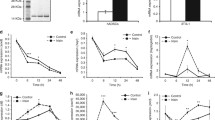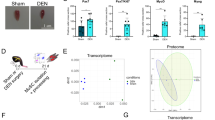Abstract
This work was undertaken to provide further insights into the expression of tropism-related genes in regenerating skeletal muscle of adult rats treated with cyclosporin-A (CsA), a calcineurin inhibitor. Rats were treated with CsA for 5 days and, on the 6th day, were submitted to cryolesion of the soleus muscles. CsA treatment continued for 1, 10, and 21 days after cryolesion. Muscles were removed, frozen, and stored in liquid nitrogen. Body and muscle weights, histological sections stained with toluidine blue, and gene expression of the regeneration molecular markers, viz., desmin and neonatal myosin heavy chain, were assessed to confirm that cryolesion and CsA treatment were effective during the allowed regeneration time. Quantitative reverse transcription/polymerase chain reaction demonstrated that myostatin gene expression was not altered by either cryolesion or CsA treatment combined with cryolesion. Calpain-3 gene expression decreased at 1 day after cryolesion and also following CsA treatment combined with cryolesion. However, calpain-3 gene expression was strongly up-regulated (approximately five-fold) 10 days after cryolesion and returned to control levels at day 21. CsA treatment blocked calpain-3 gene expression rise induced by 10 days of cryolesion. Atrogin-1 gene expression was decreased at 1 day after cryolesion and following cryolesion combined with CsA treatment, returning to control levels at day 10. These results suggest that (1) calpain-3 has a differential role in the early and late stages of regeneration in a calcineurin-dependent manner, and (2) atrogin-1 is involved in the early stages of regeneration independently of calcineurin.








Similar content being viewed by others
References
Abbott KL, Friday BB, Thaloor D, Murphy TJ, Pavlath GK (1998) Activation and cellular localization of the cyclosporine A-sensitive transcription factor NF-AT in skeletal muscle cells. Mol Biol Cell 9:2905–2916
Armand AS, Della Gaspera B, Launay T, Charbonnier F, Gallien CL, Chanoine C (2003) Expression and neural control of follistatin versus myostatin genes during regeneration of mouse soleus. Dev Dyn 227:256–265
Bassaglia Y, Gautron J (1995) Fast and slow rat muscles degenerate and regenerate differently after whole crush injury. J Muscle Res Cell Motil 16:420–429
Berchtold MW, Brinkmeier H, Muntener M (2000) Calcium ion in skeletal muscle: its crucial role for muscle function, plasticity, and disease. Physiol Rev 80:1215–1265
Bischoff R (1994) Myogenesis. McGraw-Hill, New York
Bockhold KJ, Rosenblatt JD, Partridge TA (1998) Aging normal and dystrophic mouse muscle: analysis of myogenicity in cultures of living single fibers. Muscle Nerve 21:173–183
Bodine SC, Latres E, Baumhueter S, Lai VK, Nunez L, Clarke BA, Poueymirou WT, Panaro FJ, Na E, Dharmarajan K, et al (2001) Identification of ubiquitin ligases required for skeletal muscle atrophy. Science 294:1704–1708
Booth FW, Chakravarthy MV, Spangenburg EE (2002) Exercise and gene expression: physiological regulation of the human genome through physical activity. J Physiol (Lond) 543:399–411
Bustin SA (2000) Absolute quantification of mRNA using real-time reverse transcription polymerase chain reaction assays. J Mol Endocrinol 25:169–193
Childs TE, Spangenburg EE, Vyas DR, Booth FW (2003) Temporal alterations in protein signaling cascades during recovery from muscle atrophy. Am J Physiol Cell Physiol 285:C391–C398
Chin ER, Olson EN, Richardson JA, Yang Q, Humphries C, Shelton JM, Wu H, Zhu W, Bassel-Duby R, Williams RS (1998) A calcineurin-dependent transcriptional pathway controls skeletal muscle fiber type. Genes Dev 12:2499–2509
Duguez S, Bihan MC, Gouttefangeas D, Feasson L, Freyssenet D (2003) Myogenic and nonmyogenic cells differentially express proteinases, Hsc/Hsp70, and BAG-1 during skeletal muscle regeneration. Am J Physiol Endocrinol Metab 285:E206–E215
Dunn SE, Simard AR, Bassel-Duby R, Williams RS, Michel RN (2001) Nerve activity-dependent modulation of calcineurin signaling in adult fast and slow skeletal muscle fibers. J Biol Chem 276:45243–45254
Engert JC, Berglund EB, Rosenthal N (1996) Proliferation precedes differentiation in IGF-I-stimulated myogenesis. J Cell Biol 135:431–440
Goldspink DF, Garlick PJ, McNurlan MA (1983) Protein turnover measured in vivo and in vitro in muscles undergoing compensatory growth and subsequent denervation atrophy. Biochem J 210:89–98
Gomes MD, Lecker SH, Jagoe RT, Navon A, Goldberg AL (2001) Atrogin-1, a muscle-specific F-box protein highly expressed during muscle atrophy. Proc Natl Acad Sci USA 98:14440–14445
Grounds MD, Yablonka-Reuveni Z (1993) Molecular and cell biology of skeletal muscle regeneration. Mol Cell Biol Hum Dis Ser 3:210–256
Hawke TJ, Garry DJ (2001) Myogenic satellite cells: physiology to molecular biology. J Appl Physiol 91:534–551
Heid CA, Stevens J, Livak KJ, Williams PM (1996) Real time quantitative PCR. Genome Res 6:986–994
Irintchev A, Zweyer M, Cooper RN, Butler-Browne GS, Wernig A (2002) Contractile properties, structure and fiber phenotype of intact and regenerating slow-twitch muscles of mice treated with cyclosporin-A. Cell Tissue Res 308:143–156
Jennische E, Matejka GL (1992) IGF-I binding and IGF-I expression in regenerating muscle of normal and hypophysectomized rats. Acta Physiol Scand 146:79–86
Jerkovic R, Argentini C, Serrano-Sanchez A, Cordonnier C, Schiaffino S (1997) Early myosin switching induced by nerve activity in regenerating slow skeletal muscle. Cell Struct Funct 22:147–153
Kahan BD (1989) Cyclosporine. N Engl J Med 321:1725–1738
Karpati G, Carpenter S, Prescott S (1988) Small-caliber skeletal muscle fibers do not suffer necrosis in mdx mouse dystrophy. Muscle Nerve 11:795–803
Kirk S, Oldham J, Kambadur R, Sharma M, Dobbie P, Bass J (2000) Myostatin regulation during skeletal muscle regeneration. J Cell Physiol 184:356–363
Matsuda S, Koyasu S (2000) Mechanisms of action of cyclosporine. Immunopharmacology 47:119–125
Mitchell PO, Mills ST, Pavlath GK (2002) Calcineurin differentially regulates maintenance and growth of phenotypically distinct muscles. Am J Physiol Cell Physiol 282:C984–C92
Morini CC, Pereira EC, Selistre de Araujo HS, Ownby CL, Salvini TF (1998) Injury and recovery of fast and slow skeletal muscle fibers affected by ACL myotoxin isolated from Agkistrodon contortrix laticinctus (broad-banded copperhead) venom. Toxicon 36:1007–1024
Murachi T (1989) Intracellular regulatory system involving calpain and calpastatin. Biochem Int 18:263–294
Musaro A, McCullagh KJ, Naya FJ, Olson EN, Rosenthal N (1999) IGF-1 induces skeletal myocyte hypertrophy through calcineurin in association with GATA-2 and NF-ATc1. Nature 400:581–585
Rao A, Luo C, Hogan PG (1997) Transcription factors of the NFAT family: regulation and function. Annu Rev Immunol 15:707–747
Richard I, Broux O, Allamand V, Fougerousse F, Chiannilkulchai N, Bourg N, Brenguier L, Devaud C, Pasturaud P, Roudaut C et al (1995) Mutations in the proteolytic enzyme calpain 3 cause limb-girdle muscular dystrophy type 2A. Cell 81:27–40
Richter-Reichhelm HB, Schulte AE (1998) Results of a cyclosporin-A ring study. Toxicology 129:91–94
Sakuma K, Nishikawa J, Nakao R, Watanabe K, Totsuka T, Nakano H, Sano M, Yasuhara M (2003) Calcineurin is a potent regulator for skeletal muscle regeneration by association with NFATc1 and GATA-2. Acta Neuropathol Berl 105:271–280
Salvini TF, Morini CC, Selistre de Araujo HS, Ownby CL (1999) Long-term regeneration of fast and slow murine skeletal muscles after induced injury by ACL myotoxin isolated from Agkistrodon contortrix laticinctus (broad-banded copperhead) venom. Anat Rec 254:521–533
Sharma M, Langley B, Bass J, Kambadur R (2001) Myostatin in muscle growth and repair. Exerc Sport Sci Rev 29:155–158
Sorimachi H, Forsberg NE, Lee HJ, Joeng SY, Richard I, Beckmann JS, Ishiura S, Suzuki K (1996) Highly conserved structure in the promoter region of the gene for muscle-specific calpain, p94. Biol Chem 377:859–864
Sorimachi H, Imajoh-Ohmi S, Emori Y, Kawasaki H, Ohno S, Minami Y, Suzuki K (1989) Molecular cloning of a novel mammalian calcium-dependent protease distinct from both m-types and mu-types. Specific expression of the mRNA in skeletal muscle. J Biol Chem 264:20106–20111
Sorimachi H, Suzuki K (2001) The structure of calpain. J Biochem (Tokyo) 129:653–664
Stockholm D, Herasse M, Marchand S, Praud C, Roudaut C, Richard I, Sebille A, Beckmann JS (2001) Calpain 3 mRNA expression in mice after denervation and during muscle regeneration. Am J Physiol Cell Physiol 280:C1561–C1569
Stupka N, Gregorevic P, Plant DR, Lynch GS (2004) The calcineurin signal transduction pathway is essential for successful muscle regeneration in mdx dystrophic mice. Acta Neuropathol Berl 107:299–310
Vierck J, O’Reilly B, Hossner K, Antonio J, Byrne K, Bucci L, Dodson M (2000) Satellite cell regulation following myotrauma caused by resistance exercise. Cell Biol Int 24:263–272
Walro JM, Kucera J, Narvy R (1991) Non-neural and neural expression of myosin heavy chains by regenerated intrafusal fibers of rats. Neurosci Lett 122:213–217
Wernig A, Irintchev A (1995) “Bystander” damage of host muscle caused by implantation of MHC-compatible myogenic cells. J Neurol Sci 130:190–196
Wernig A, Irintchev A, Lange G (1995) Functional effects of myoblast implantation into histoincompatible mice with or without immunosuppression. J Physiol (Lond) 484:493–504
White TP, Esser KA (1989) Satellite cell and growth factor involvement in skeletal muscle growth. Med Sci Sports Exerc 21:S158–163
Wilson SJ, Harris AJ (1993) Formation of myotubes in aneural rat muscles. Dev Biol 156:509–518
Acknowledgements
We thank A.C. Partezani for excellent technical assistance.
Author information
Authors and Affiliations
Corresponding author
Additional information
This work was supported by FAPESP (Fundação de Amparo a Pesquisa do Estado de São Paulo, Brazil). E.H. Miyabara is a fellow of FAPESP (02/03195-2).
Rights and permissions
About this article
Cite this article
Miyabara, E.H., Aoki, M.S., Soares, A.G. et al. Expression of tropism-related genes in regenerating skeletal muscle of rats treated with cyclosporin-A. Cell Tissue Res 319, 479–489 (2005). https://doi.org/10.1007/s00441-004-1027-y
Received:
Accepted:
Published:
Issue Date:
DOI: https://doi.org/10.1007/s00441-004-1027-y




